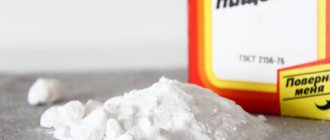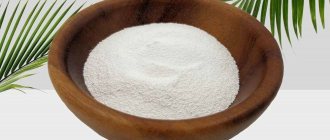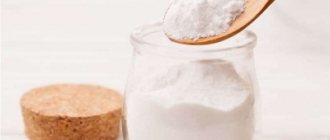Nowadays you can find baking soda, caustic soda and soda ash on sale. Each option has its own scope of application. Baking soda is used in cooking, and soda ash is used as a disinfectant and in industrial production.
Caustic soda is the most dangerous alkali that can be used in everyday life. When working with this substance, special care must be taken, because... it can cause not only skin burns if it comes into contact with it, but also damage to the organs of the pulmonary system if the vapors are accidentally inhaled.
What is caustic soda?
Caustic soda is primarily an alkali that can corrode organic matter, while it is an excellent stain remover. Compared to baking soda and soda ash, caustic soda has a greater cleaning effect. Caustic soda is produced in the form of a powder, in which you can see small crystals and flakes, painted white. In addition, the powder does not have any odor, and the size of the grains does not exceed 1-1.5 mm.
Compound
Caustic soda consists of oxygen, sodium and hydrogen molecules, as evidenced by the structural formula of the substance NaOH. It will not be possible to find caustic soda in its pure form; it is obtained industrially from a solution of table salt. At the same time, the norm for caustic soda is considered to be no less than 98.5%. Caustic is produced both solid and in liquid form. Transported in bags or special containers.
Solid caustic, when dissolved in water, is capable of generating heat. You should use caustic with caution, as caustic soda can be harmful to health if safety rules are not followed.
Operating principle
The principle of action of caustic soda is that when it comes into contact with fatty deposits, it dissolves the fat, and if you use it when cleaning sewers, it can easily cope with organic substances that accumulate on the walls of pipes.
If caustic soda is poured into the clogged area, it will soften it, and the problem will be solved in a short period of time. After peeling off the resulting blockage and exposure to the substance, it is washed with water, pushing the blockage further along the pipe opening.
Are caustic soda and soda ash the same thing?
Caustic and soda ash are two different substances, but they are united by their alkaline origin and base. The main difference between one soda and another is its chemical composition, as well as its effectiveness. It is known that soda ash is not very effective in dealing with blockages in the sewer; when using it, there will be practically no effect. Caustic soda can deal with this problem in an instant.
Caustic soda is an alkali, and soda ash is practically the same baking soda that many people use for baking and at home.
Where can I buy
Caustic soda can be purchased at hardware stores. Sometimes it is found in departments specializing in the sale of goods for soap makers. It can also be found on the Internet: on sites specializing in the supply of caustic soda. The price per kilogram usually does not exceed 100 rubles.
Sodium hydroxide is often included in multi-component products designed to clean dishes, cesspools and sewer pipes. You can find them in departments offering household chemicals. Such products are intended for home use and are therefore relatively safe. In addition, their effectiveness is higher than that of conventional caustic alkali due to the inclusion of additional ingredients.
Caustic soda can cope with complex stains on dishes and facilitate the process of cleaning sewers and waste pits, but it can only be used if precautions are carefully observed.
If this substance gets on the mucous membranes or skin in the absence of timely help, it can have irreversible consequences. Therefore, for home use it is better to choose safer options.
What is caustic soda used for in everyday life?
In agriculture
In agriculture, caustic soda is used to disinfect premises where livestock are kept. At the same time, not only the territories are processed, but also all equipment.
Removing scale and deposits from dishes
Caustic does an excellent job of removing scale and deposits that form on dishes. You can do this as follows:
- To 10 liters of water, add 200 g. caustic.
- Grind 20 gr. laundry soap and add to the soda solution.
- Mix thoroughly until the ingredients are completely dissolved.
- Add 150 ml of office glue to the dishes that you plan to clean.
- Stir, put on fire and bring to a boil.
- It is recommended to boil dishes with scale and carbon deposits in this solution for 1–2 hours.
- Remove the dishes from the solution and wash with detergent.
- Rinse in running water.
This method is suitable for cookware made of enamel, cast iron and steel. It is under no circumstances recommended to clean Teflon coatings and aluminum utensils with caustic soda.
Making homemade soaps and detergents
You can use caustic soda to make homemade soap or cleaner. Recipe:
- In 150 gr. distilled water, brought to a boil, dilute 70 g. purified caustic soda.
- Flaxseed, sea buckthorn or almond oil, 0.5 kg is enough, heat in a water bath.
- Add it to the soda solution.
- To stir thoroughly.
- Pour into prepared pans.
- Keep in a dry place for several days, then remove the finished soap.
Removing blockages, cleaning drains
Some housewives clean sewers using caustic soda for a private home. This method effectively copes with any blockages.
- In a 4-liter container with cold water, add 200 g. caustic.
- To stir thoroughly.
- Pour it down the drain.
- Do not use the toilet for 1–2 hours, as the water from the flush can wash away the caustic soda and there will be no positive effect.
- After this time, rinse with 15 liters of hot water and pour it into the drain.
Cesspool cleaning
When cleaning cesspools, the proportions of substances depend directly on its size and depth.
For the procedure you will need:
- Protective gloves.
- Shovel.
- Bucket.
- Respirator.
The procedure is carried out as follows:
- 3-4 kg of caustic soda is poured into a bucket.
- Pour in 5–7 liters of water.
- Mix thoroughly.
- Pour into the cesspool.
- The procedure is carried out until the pit is completely cleared.
For disinfection
Caustic is also used for disinfection during wet cleaning.
Scope of application of sodium hydroxide
On an industrial scale, caustic alkali is used for:
- determining the acid concentration or neutralizing its effect;
- aluminum processing;
- regulation of acid levels in food;
- wastewater treatment from heavy metals;
- normalization of water pH;
- manufacturing of medicines;
- giving cotton fabrics a silky shine;
- production of cosmetics.
At home, caustic soda is used mainly for cleaning sewers and cesspools.
Caustic soda in other areas
Caustic soda is used in many applications. For example, in veterinary medicine I use it to disinfect animal premises; in addition, it is used in the food, textile, pulp and paper, chemical and automotive industries. Let's take a closer look.
Use in veterinary medicine
Caustic soda is used to disinfect premises where livestock are kept. Veterinarians recommend treating these areas daily with a concentrated caustic solution. The permissible dosage of caustic soda concentration is 1%, and if animals have infectious diseases, it is increased to 10%.
Industrial Applications
In industry, caustic is used in the following industries:
- Based on it, the food additive E-524 is prepared, which is subsequently used for the preparation of chocolate products, ice cream and various drinks.
- In the production of silk products and for bleaching fabrics.
- They produce paper and cardboard.
- Manufacture of detergents.
- In the production of car batteries and fuel.
Industrial Applications
This substance is actively used in the production of many types of consumer goods. Caustic soda is used in the food industry. It is designated as additive E-524 and is often used in the manufacture of ice cream, drinks and chocolate. In addition, soda solutions are used to clean equipment.
In the textile industry, this substance is used to bleach fabrics and produce silk. In addition, caustic soda is used in the manufacture of cardboard and paper. This substance is an essential component in the production of detergents. Caustic soda is necessary for the production of alkaline batteries for cars and biodiesel fuel.
This chemical is used in the defense industry to eliminate carbon dioxide and to produce breathing apparatus.
Advantages and disadvantages
Caustic soda has both advantages and disadvantages.
Advantages:
- Quickly and effectively copes with organic contaminants.
- Has a simple application for cleaning drains.
- Completely soluble in water.
- It is not capable of harming plastic, cast iron, rubber and other materials used in sewerage parts.
- Quite a low price for the substance.
Flaws:
- Caustic soda is a substance that has a strong effect and quite high toxicity.
- Affects only organic substances.
- Has a negative effect upon contact with galvanized, aluminum and enamel coating.
- The substance should be stored only in closed form.
- Short shelf life, only 12 months.
General characteristics
The chemical formula of caustic soda, NaOH, which is common in everyday life, indicates that it belongs to a variety of powerful alkalis. Known by several other names. Caustic is more commonly used, caustic soda is found, and the name sodium hydroxide is less commonly used.
It is a solid white substance. In powder form, it looks like scaly miniature granules. They are practically devoid of a specific smell.
Caustic is hygroscopic. Easily dissolves in water. Directly in this case, a reaction occurs with the release of a significant amount of heat. The resulting solution is soapy to the touch.
Expert opinion
We recommend!
Produced in powder and liquid form. Sodium hydroxide, in addition to industrial applications, is widely used to solve some household problems. Along with the effectiveness of the product, the affordable price attracts.
How to use soda to get rid of blockages?
Using soda to deal with clogs is quite simple, the main thing is to follow the instructions. And they do it like this:
- Pour 150 grams into the drain. caustic soda.
- Pour 2 liters of boiling water.
- Leave for 15–20 minutes.
- After this, add another 2 liters of hot water.
- Do not use the bathroom for an hour.
- Rinse the drain with 15–20 liters of water.
Cleaning with solution
To combat the blockage, it is necessary to properly prepare the solution. And you can do it like this:
- Add 2-3 kg of caustic to 8 liters of water.
- Mix thoroughly until the granules are completely dissolved.
- Slowly pour half the solution down the drain.
- After a few hours, pour out the rest.
- Flush the drain with plenty of running water.
Powder cleaning
To combat blockages using caustic soda powder, simply pour a small amount of the substance into the toilet bowl and add plenty of water. This must be done with caution, as this method can damage the sewer pipes and this can lead to leakage. Therefore, experts recommend using a small amount of the active substance and then caustic soda will do an excellent job not only with the blockage, but also corrode all the organic matter deposited on the walls of the pipes.
Gel cleaning
Clearing the blockage using a gel based on caustic soda is a less safe method, unlike the previous option. To clean, you need to mix 100 ml of gel with 250 ml of boiling water, mix thoroughly and pour into the sewer hole. Leave for several hours, then rinse with plenty of running water.
Is it possible to clean plastic pipes with caustic soda?
Cleaning plastic pipes with caustic soda is highly not recommended. It should be remembered that this substance is an alkali and may well harm the plastic product. It is better to figure out the reason why the blockage occurs periodically or use more gentle means.
Operating principle
Caustic sodium has an aggressive effect on various types of contaminants. It dissolves dirt and softens the plaque layer. After the substance has worked for several hours, you need to pour a large amount of water into the pipeline to wash away the contaminants.
Caustic soda can be used to dissolve organic waste in plastic pipes. Polymers are inert materials that do not react with chemicals. Dirt slowly accumulates on the smooth plastic walls.
Sewer plastic pipes (Photo: Instagram / armada_tmb)
How to flush a radiator with caustic soda?
You can only flush the radiator with caustic soda if it is made of cast iron or chrome-nickel steel. It is prohibited to use this method for radiators made of aluminum, iron, tin, zinc or lead, since when interacting with this metal, the caustic becomes an explosive substance.
Radiator flushing method:
- Flush the radiator in the summer, after turning off the heating completely.
- To do this, use a pump to pump a 15% caustic soda solution into the radiator.
- Leave the substance inside the heating device for 2–3 days.
- Drain the solution and wash with plenty of water.
Production
Until the 17th century, various substances were called soda and no research was carried out on these substances. With the growth of industrial production, the need for these products has increased. Then various studies and experiments began on the industrial production of soda. In 1736, Henri Monceau was able to divide the common name into three chemical compounds: soda itself - sodium carbonate, potassium carbonate and sodium hydroxide. In 1764, a chemical method for producing soda was discovered.
Over the century, several options for the production of soda were proposed (ammonia, lime), but only the lime method, which existed until the 20th century, was widely used. Today, a similar technique (Figure 2) is used as an experiment for chemistry lovers.
Figure 2 – Chemical method for producing caustic soda
At the end of the 19th century, a new method for producing caustic soda appeared - electrochemical, which is still used today.
The need for caustic soda is only growing from year to year. Russia occupies only 1% of production on the world market (Figure 3). The leaders in both consumption and production of sodium hydroxide are China, the USA and the European Union.
Figure 3 – Production and consumption of caustic soda in the world
At the same time, in the Russian Federation itself the market is filled with domestic products. The main Russian manufacturers are coping with market needs (Figure 4). It is worth noting that the caustic soda market in the Russian Federation is developing more slowly than global markets.
Figure 4 – Main Russian producers of caustic soda, their share in total production
How to fertilize garden trees with caustic soda?
Many gardeners treat garden trees with caustic soda in order to save them from diseases such as late blight, powdery mildew, black spot, and various fungi. This method differs from others in that it is quite cheap and effectively copes with the disease, increasing the abundance of the crop.
To treat trees and shrubs, you need to mix 10 liters of water and 5-6 tbsp. l. caustic, mix and water the plants. Greenhouses are also treated with this solution for disinfection before planting seedlings.
On a suburban area
Caustic soda helps gardeners and residents of country houses disinfect and save plants from pests.
Recommended for you:
How to use soda against aphids: in the garden, in the garden, at the dacha
Cleaning the cesspool
Before using caustic soda to clean a cesspool, you should make sure that it is sealed and equipped with a properly functioning ventilation system. This eliminates the entry of caustic into the soil, which has a negative impact on its structure and nutritional characteristics.
A little more than half the volume of water is poured into a twelve-liter bucket. While stirring vigorously, add 2 kg of caustic soda with a wooden spatula. After the intense release of heat has ended, the liquid composition is poured into the pit. Repeat this procedure twice.
How to clean dishes with caustic soda?
To clean the dishes, you need to do the following:
- Pour water into the contaminated container.
- For every 10 liters, you will need 200 grams. caustic.
- Add laundry soap, grated on a fine grater.
- Pour in 150 gr. office glue.
- Carefully move the solution.
- Place on fire and bring to a boil.
- Cook for 1.5-2 hours.
- Pour the solution into the sink.
- Wash dishes with detergent.
- Rinse thoroughly in running water.
This method is used for pots, pans and plates. The main thing to remember is that after the solution boils, it is recommended to keep the dishes in it for no more than 20 minutes.
Exclusive soap
Many housewives prefer to use homemade soap. It is safer because high-quality and proven components are used.
Recommended for you:
How to clean a mattress with baking soda
Sequencing:
- Vegetable oil - 500 ml is poured into an enamel saucepan and slightly heated.
- In a separate earthenware bowl, combine caustic soda - 70 g and distilled water - 150 ml.
- After the end of the violent reaction, pour the soda solution into the oil. Stir with a wooden spatula until the caustic is completely dissolved.
- After obtaining a fairly thick, homogeneous mass, add aromatic herbs ground into powder - 2 tbsp. l. or essential oil with your favorite scent - 5 drops.
- Pour the gel-like substance into a low container, preferably rectangular in shape. Place in a dry place.
- After four days, the resulting soap is carefully cut with a sharp knife, forming pieces of the desired size, and left to mature.
Expert opinion
We recommend!
The readiness of the soap is determined by the whitish coating that appears on the surface. The process lasts up to one and a half months. Homemade soap with impressive cleansing properties lathers well and undoubtedly has a pleasant aroma.
Safety regulations
When using caustic soda, the following safety precautions must be observed:
- Use a respirator and protective gloves.
- Store the substance in a dark place out of reach of children and animals.
- Use strictly according to the instructions, observing the proportions.
Storage requirements
It is recommended to store caustic soda in a dry and dark place in an airtight container. The lid must be tightly closed, and exposure of the substance to sunlight should be avoided. It is better to choose a storage place such that neither animals nor children can reach it.
Possible consequences
Improper storage may result in poisoning of pets, who may accidentally ingest small amounts of the substance. And if a child gets to the caustic, he may well get a burn to the skin or mucous membrane. In these cases, you should definitely seek help from a doctor. You should pay attention to the expiration date; after it expires, the caustic becomes less effective and it is better to avoid using it.
What things can be soaked in caustic soda?
You can soak white clothes in caustic soda. Since this substance is alkaline, it will do an excellent job with difficult to remove stains. It is not recommended to soak linens made of cotton and other delicate fabrics; caustic acid can damage them.
Can caustic soda be used to wash your hands?
Caustic soda can be used to wash your hands, but you must first dilute it in water and then start washing. To prepare a solution for 5 liters, 1–2 tbsp is required. l. caustic, if you put more alkali, a burn may appear on the skin. Caustic handwash is used as an antiseptic.
What to do in case of a caustic burn?
If caustic gets on the mucous membrane, it is recommended to rinse the area with 2% boric acid, and if it gets on the skin, then 5% vinegar, diluting both substances in a small amount of cold water. Only after this can you begin to treat areas with caustic burns.
Although caustic soda is a dangerous chemical, the effectiveness of its use is unlikely to leave anyone indifferent. The main thing is to follow the instructions and strictly observe the proportions, and then no problems will arise, and your dishes and drains will not need to be cleaned for a long time.
How to treat a burn
Attention! If caustic soda gets into your eyes, rinse them with cool water for several minutes.
First aid for damaged skin includes several points:
- Washing off the alkali. The procedure must be carried out for at least 20 minutes. Only water can be used for cleaning. Wet wipes or a dampened towel are not suitable, as they may cause the reagent to penetrate deeper into the skin structure.
- Neutralization of alkali action. At this stage, the damaged area is treated with an aqueous solution of vinegar or lemon juice.
- Relieving pain. To implement this point, apply a bandage soaked in cold water to the burn site or take painkillers.
Attention! If the damaged skin becomes blistered, you should immediately call an ambulance.
Pros and cons of pipeline cleaning with caustic soda
The advantages of using caustic soda to clean sewer elements are based not only on the destructive properties of the substance, which can dissolve blockages and remove plaque. Additional advantages are:
- smoothing out irregularities on the internal surfaces of pipe sections, which prevents the appearance of deposits;
- duration of exposure - the reaction continues even after rinsing;
- low cost.
As a preventive measure, it is enough to carry out one cleaning every 30 days.
A special feature of the use of sodium hydroxide is that it is used to clean sewers in residential buildings and in industries - to clean pipelines and boilers. It is also often used after cleaning with acidic agents to restore balance and keep the surface of the pipes intact. Additionally, caustic agents are suitable for cleaning main pipelines, including sewer ones, using the “shock wave” method.
The hygroscopicity of a substance has its pros and cons. It is not difficult to prepare a solution of caustic soda, but the soda should be stored in sealed bags so that it does not become saturated with moisture.
The disadvantages of using it include the fact that soda can destroy the enamel of bathtubs and sinks. It also has difficulty removing dirt and soil. If used carelessly, you can get a chemical burn.











